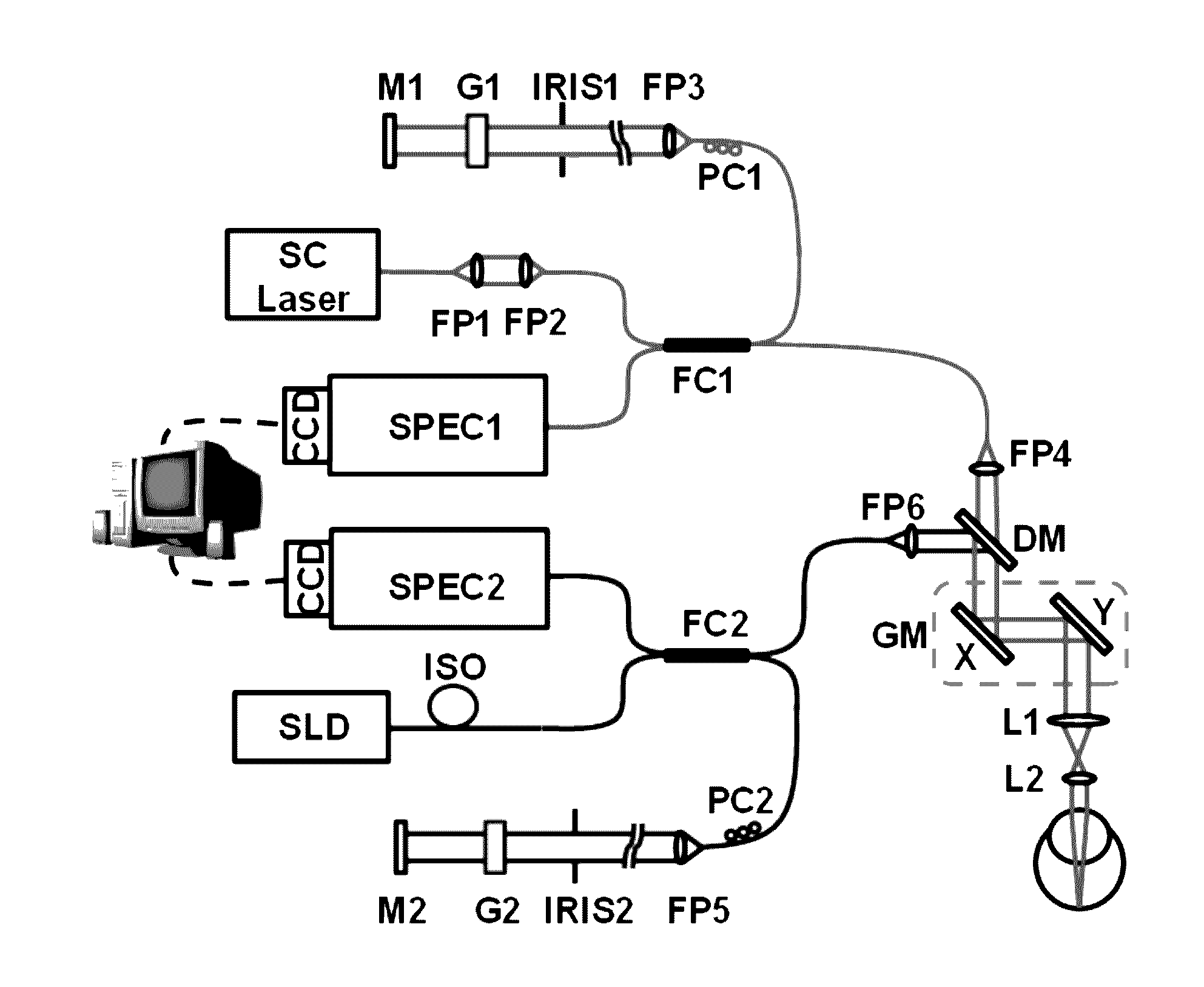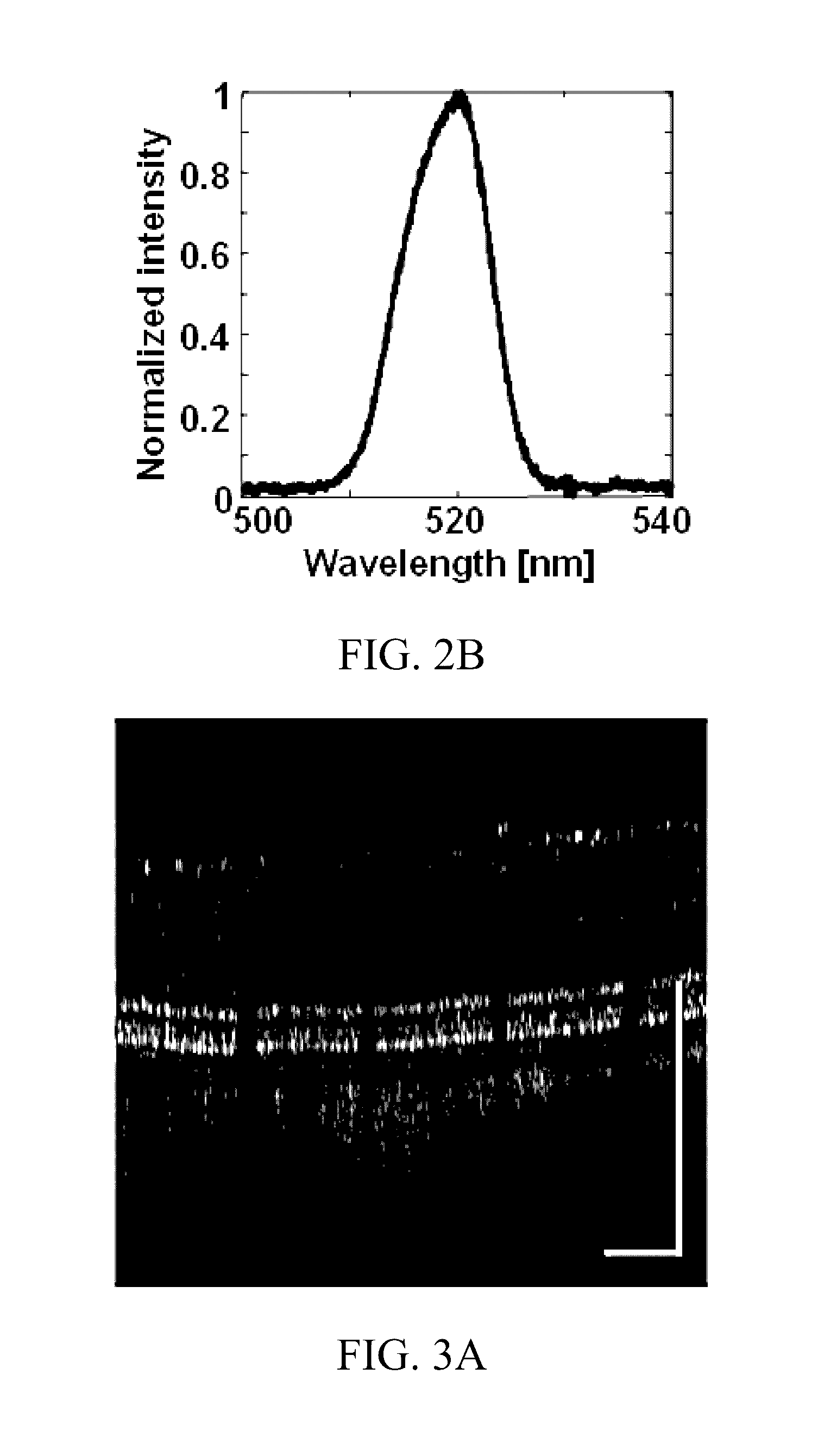Functional imaging of photoreceptors in the retina by rhodopsin mapping
a technology of rhodopsin and photoreceptors, applied in the field of functional imaging of photoreceptors in the retina by rhodopsin mapping, can solve the problems of vision loss, personal tragedy, burden on society, and little progress in quantitative assessmen
- Summary
- Abstract
- Description
- Claims
- Application Information
AI Technical Summary
Benefits of technology
Problems solved by technology
Method used
Image
Examples
example 1
[0101]A schematic of the NIR / VIS-OCT imaging system is shown in FIG. 1. The system comprises two independent spectral domain-OCT subsystems, one of which is equipped with a near-infrared (NIR) light source for guiding the image alignment process in a dark environment and the other is equipped with a visible (VIS) light source for rhodopsin imaging.
[0102]The VIS-OCT employs a supercontinuum laser source (EXB-6, SuperK EXTREME, NKT Photonics, Denmark) equipped with a variable band-pass filter (SuperK Varia, NKT Photonics). The filtered light output (center wavelength: 520 nm, bandwidth: 9.3 nm, 80 MHz pulse rate) is delivered though a fiber delivery module. The VIS light is coupled into the source arm of a single-mode optical fiber-based Michelson interferometer by using a pair of identical fiber ports (PAF-X-11-A, Thorlabs). The NIR-OCT employs a superluminescent diode (SLD-37-HP, center wavelength: 840 nm, bandwidth: 50 nm, Superlum, Russia). The NIR- and VIS-OCT probe light beams a...
example 2
[0106]Two animal models were used for imaging rhodopsin with the NIR / VIS-OCT. The first model comprised albino rats with normal retina (Sprague Dawley, 200-400 g, Harlan Laboratories), and the second model comprised wild-type pigmented rats (Long Evans, 200-400 g, Harlan Laboratories).
[0107]The rats were dark-adapted for about 4 hours prior to each experiment (Behn, D. et al. Dark adaptation was faster in pigmented than albino rats. Doc Ophthalmol. 106, 153-159 (2003)). A cocktail containing ketamine (54 mg / kg body weight) and xylazine (6 mg / kg of body weight) was intraperitoneally injected for anesthesia. The rat's pupil was dilated with 0.5% tropicamide ophthalmic solution and 0.5% proparacaine hydrochloride ophthalmic solution. After the rats were sedated, a powerless contact lens was put on the eye to prevent cornea dehydration and cataract formation (Liu, X. et al. Effect of contact lens on optical coherence tomography imaging of rodent retina. Curr Eye Res. 38, 1235-1240 (2013...
example 3
[0109]The following example pertains to imaging rhodopsin using an albino rat. The VIS source had a center wavelength of about 530 nm and a bandwidth of about 9.3, enabling a depth resolution of about 13 μm in air. The NIR source operated at a center wavelength of about 840 nm. Following dark-adaptation for about 4 hours, the retinal area of interest was located and the retinal image was optimized using the NIR-OCT, which was then turned off and the VIS-OCT was turned on to acquire a full 3D OCT dataset. The acquisition time was 1 second for an imaging volume containing 512×128 depth scans (A-scans).
[0110]Rhodopsin was then bleached by bright room light (˜800 lx) for about 15 seconds, followed by acquisition of two light-adapted 3D images of the same retinal area. Each OCT cross-sectional image (B-scan) was manually segmented along the junction between the inner and outer segments (IS / OS) of the photoreceptors. An en-face view of the segmented OCT data was generated by summing the s...
PUM
 Login to View More
Login to View More Abstract
Description
Claims
Application Information
 Login to View More
Login to View More - R&D
- Intellectual Property
- Life Sciences
- Materials
- Tech Scout
- Unparalleled Data Quality
- Higher Quality Content
- 60% Fewer Hallucinations
Browse by: Latest US Patents, China's latest patents, Technical Efficacy Thesaurus, Application Domain, Technology Topic, Popular Technical Reports.
© 2025 PatSnap. All rights reserved.Legal|Privacy policy|Modern Slavery Act Transparency Statement|Sitemap|About US| Contact US: help@patsnap.com



